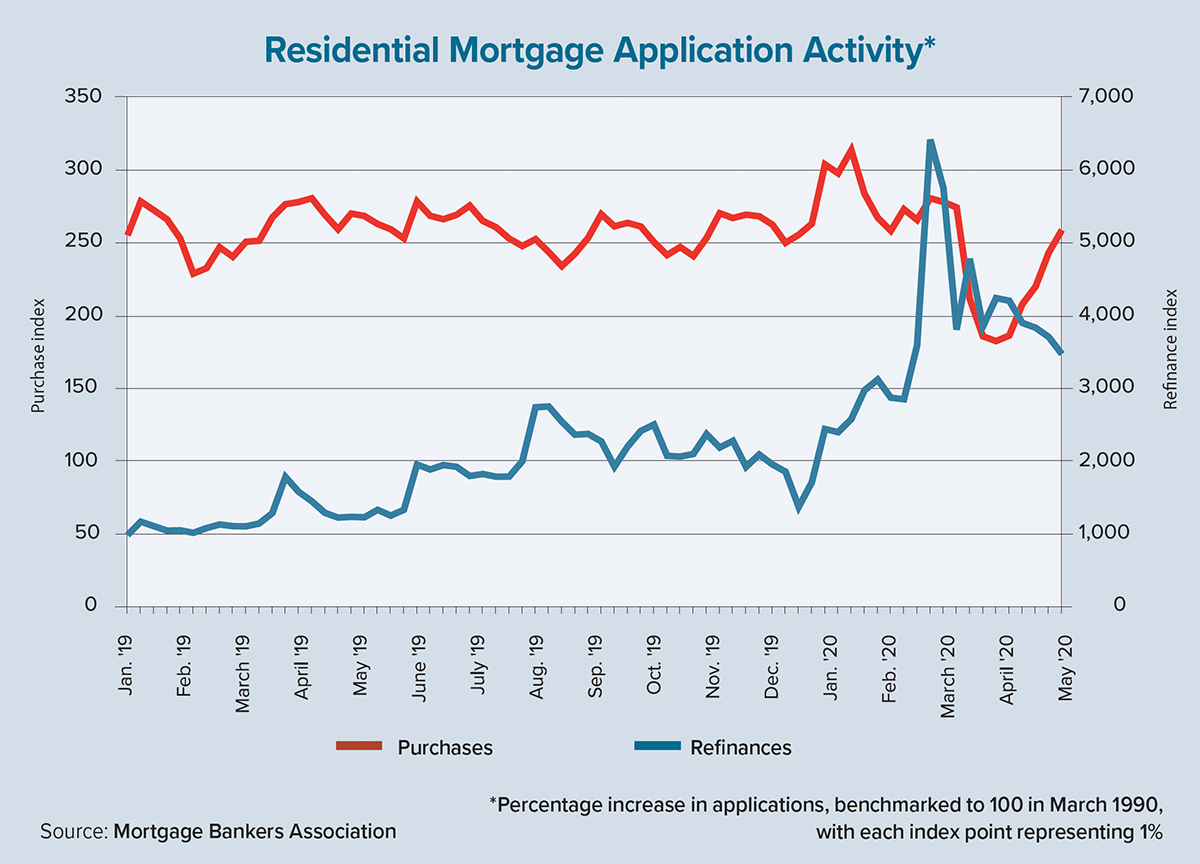It seems like just yesterday that the U.S. economy was enjoying record-low unemployment, rising wage growth and upbeat consumers comfortable with their spending habits. With steady interest rates averaging less than 4%, the mortgage industry also was celebrating early this year, and purchase and refinance applications were consistently outpacing levels from a year earlier.
The vibrant economy — and our sense of normalcy — came crashing down thanks to one of the worst pandemics in a century. Within weeks, COVID-19 was in every state despite the nation’s collaborative efforts to essentially shut down the economy and stay home for weeks on end.
These extraordinary attempts to slow the coronavirus have come at a detrimental cost to the economy. Some unprecedented relief measures have occurred in response. Trillion-dollar stimulus bills were passed by Congress. The Federal Reserve made several moves, including cutting benchmark interest rates to near zero. Furthermore, the Federal Housing Finance Agency and Ginnie Mae launched nationwide forbearance programs for federally backed mortgages, or roughly 60% of the U.S. mortgage market.
The pandemic is inflicting considerable pain on the health and finances of households and businesses. Unemployment has skyrocketed, economic growth has plummeted, and without an effective treatment or vaccine, it is likely that COVID-19 will continue to weigh on the economy.
For households looking to reduce their monthly mortgage payments, one silver lining has emerged: record-low mortgage rates. Refinance activity through the first five months of this year has soared, even compared to last year’s solid activity. As of this past May, the Mortgage Bankers Association (MBA) called for refinance originations in 2020 to rise 32% year over year to $1.19 trillion.
Across the purchase market, record-low rates are keeping housing affordability in check even as meager supply levels place upward pressure on home prices. Buying a home, however, is a big decision that often reflects strong confidence about a household’s job prospects and finances. The economic and labor-market fallout from COVID-19 has thrown a wrench into these plans.
The good news is that after a sizable drop in April 2020, purchase activity gradually improved as states reopened and homebuyers ventured out. Any meaningful return to the pre-pandemic home-sales pace will depend on containing the virus and reducing the sky-high unemployment rate. For now, MBA is forecasting that purchase originations will come in slightly below last year’s volume of $1.27 trillion.
MBA’s most recent forecast for total originations in 2020 is $2.44 trillion, which would be the best year since 2006 ($2.73 trillion). One impediment to even rosier expectations is that, unsurprisingly, credit availability has tightened considerably. Many lenders are dropping low credit-score and high-leverage programs, as well as jumbo loans, non-QM products and cash-out refinances. Credit supply should stabilize in the coming months, but lenders are certainly adapting to a cloudy economic outlook.
It also is clear that the pandemic is impacting current homeowners. The national delinquency rate in first-quarter 2020 jumped annually by 59 basis points to 4.36%. Although that rate is still low, it’s important to remember that most of the first quarter was pre-pandemic.
Early this past May, an MBA survey revealed that the share of loans in forbearance was 8.16%, or roughly 4.1 million homeowners. It is inevitable, as signs of economic distress continued into the second quarter, that mortgage delinquencies will increase.
This is a rapidly evolving situation with new developments occurring daily. In fact, by the time you read this, the outlook might be much brighter. Expect that the combination of $1,200 stimulus checks, enhanced unemployment insurance benefits, and other supports for households and businesses will soften the blow from this abrupt economic downturn. The mortgage industry will continue to play an important role in the recovery by helping borrowers affected by the pandemic, and by offering purchase and refinance mortgages at historically low interest rates.
Author
-

Mike Fratantoni is chief economist and senior vice president of research and industry technology at the Mortgage Bankers Association (MBA). He is responsible for overseeing MBA’s industry surveys, benchmarking studies, economic and mortgage origination forecasts, industry-technology efforts, and policy-development research for the single-family and commercial/multifamily markets. Prior to joining MBA, Fratantoni worked in risk management and senior economist roles at Washington Mutual and Fannie Mae.





